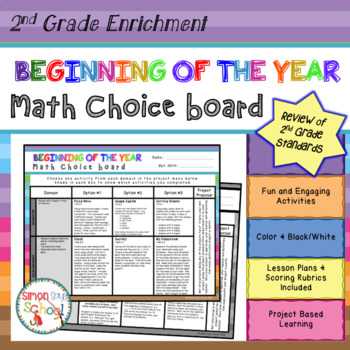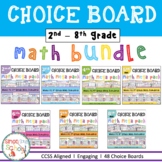Beginning of the Year Math Review Choice Board – 2nd Grade - Distance Learning
- PDF
Also included in
- 2nd Grade Math Project Mega Pack – ALL Year Long - ALL CCSS Standards - This choice board bundle is a simple, year-long differentiated tool for ALL 2nd grade standards.This resource includes… - Beginning of the Year Math Review Choice Board – 2nd Grade - Operations and Algebraic Thinking ChoiPrice $12.00Original Price $14.00Save $2.00
- Math Choice Board Ultimate Bundle – Elementary and Middle School Standards – Year Long– This choice board bundle is a simple, year-long differentiated tool for ALL CCSS standards. It is perfect for distance learning and includes… · Second Grade· Third Grade· Fourth Grade· Fifth Grade· Sixth Grade·Price $88.80Original Price $111.00Save $22.20
- Enrichment Math Choice Board Ultimate Bundle – Elementary CCSS Standards – Year Long– This choice board bundle is a simple, year-long differentiated tool for ALL Standards. It is perfect for distance learning and includes… · Second Grade· Third Grade· Fourth Grade· Fifth Grade This bundle includesPrice $50.40Original Price $63.00Save $12.60
Description
Beginning of the Year Math Review Choice Board – 2nd Grade – This fun and engaging choice board is an amazing differentiation tool where students review key 1st grade math standards while simultaneously helping you identify gaps in their learning and providing you with valuable information about the interests and readiness of all of your students. There is no question students will be hooked and empowered from day one using this menu activity board.
This board contains three activities for each domain:
- Geometry
- Measurement
- Numbers and Operations in Base Ten
- Operations and Algebraic Thinking
Students can either choose to complete activities from the project menu or design their own projects with the approval of their teachers by completing the project proposal.
This choice board menu project includes…
- Sample Lesson Plans
- Menu Choice Board
- Project Proposal
- Project Rubric
- Presentation Rubric
* * * * * * * * * * * * * * * * * * * * * * * * * * * * * * * *
Please come back and check out MY STORE for additional resources.
CHECK OUT THESE OTHER CHOICE BOARD MENUS (click on each to view):
Operations and Algebraic Thinking Choice Board – 2nd Grade
Measurement Choice Board – 2nd Grade
Numbers and Operations Choice Board – 2nd Grade
Geometry Choice Board – 2nd Grade
Math Choice Board Mega Pack – Year Long – All 2nd Grade Standards
End of the Year Math Review Choice Board – 2nd Grade Standards
Math Choice Board Mega Pack – Year Long – All 2nd Grade Standards
* * * * * * * * * * * * * * * * * * * * * * * * * * * * * * * *
Please click the "Follow Me" link located under my picture and store name on the right-hand column of this page to keep updated on all my new offerings!
You can also learn more by visiting….








